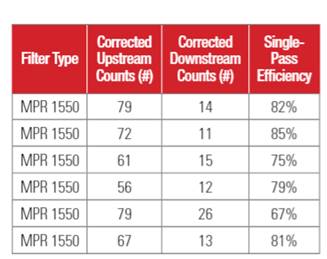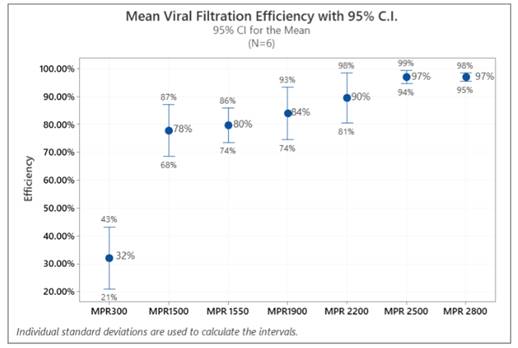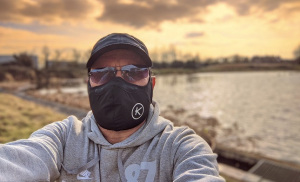
Coronavirus
Technology Solutions
April 13, 2021
Biota Launches
COVID-19
Diagnostic in
Wastewater
A
First-Of-Its-Kind
Antimicrobial
Stainless Steel
Copper Foam as a
Highly
Efficient,
Durable Filter
for Reusable
Masks and Air
Cleaners
3M HVAC Filters
have Viral
Removal
Efficiencies
from 60% to 90%
Lydall Increases
Filter Media
Prices
HEPA Room
Purifiers in
Every Classroom
at a Cost of $1
billion
KYMIRA has Two
Nanofiber Layers
to Maximize Mask
Efficiency
_________________________________________________________________________
Biota Launches
COVID-19
Diagnostic in
Wastewater
Biota
Technology, a
pioneer of
industrial
genomics,
announced the
creation of a
new business
line to manage
pathogen risk in
the
post-pandemic
economy.
Following
the
recent transaction with
Novozymes, Biota
is launching
diagnostics in
an emerging,
high-growth
opportunity to
further broaden
its genomic
platform: high
throughput
genomic
monitoring of
wastewater to
detect and
defend against
pathogen risks.
"Biota's new
offering
addresses a
global,
long-term need
to detect and
proactively
mitigate risks
associated with
potential
disease
outbreaks," said
Ajay Kshatriya,
Board Chairman.
"Genomic
wastewater
monitoring
enables early
intervention and
broad protection
for employees,
customers, and
the general
public in a
variety of
enterprise
segments."
Biota recently
entered into a
collaboration
with Pangolin
Health to
develop
technical
workflows and
analytic methods
for a number of
customers in the
Southwestern US.
"Biota offered
us the
opportunity to
leverage their
extraordinary
work in
difficult
industrial
environments
into the
similarly
challenging
wastewater
setting.
Because pathogen
detection in
wastewater is
comprehensive,
inclusive and
always on, it's
an instrumental
source of
critical data
for pandemic
management and
control. This is
relevant both
for the current
coronavirus and
its variant
strains, and the
next
pathogen," says, Dr. Bryan
Walser, M.D.,
Executive
Chairman of
Pangolin Health.
Along with
new investments
in pathogen
diagnostics,
Biota continues
to grow its core
energy business.
Recent efforts
include
geographic
expansion via
strategic
engagements with
a national oil
company in
the Middle East,
and further
developing
solutions for
customers in
conventional and
unconventional
plays.
Additionally,
Biota is
expanding the
energy market
opportunity with
low carbon
product concepts
in carbon
capture,
utilization and
storage (CCUS)
and geothermal
energy.
As Biota
continues to
advance its
industrial
genomics
platform across
multiple
sectors, the
company
leadership is
evolving with
the appointment
of Mathias
Schlecht,
Ph.D. to Chief
Executive
Officer and Ajay
Kshatriya to
Chairman of the
Board.
"I've never been
more excited
about Biota's
vision to
pioneer
industrial
genomics across
multiple
sectors,"
said Mathias
Schlecht, Chief
Executive
Officer. "With a
global footprint
in the energy
market and
rapidly growing
market for
pathogen risk
management,
Biota has the
corporate
strategy,
commercial
scale, and
technical
capabilities to
develop new
solutions across
the industrial
sector and
create a
billion-dollar
enterprise."
A
First-Of-Its-Kind
Antimicrobial
Stainless Steel
Advancing
Medical
Innovations
(AMI) announced
that its client,
Performance
Compounds Inside
(PCI), has made
historic
advancements in
metallurgy with
its 3PRE
Technology, a
novel and
proprietary
process of
activating
antimicrobial
properties.
PCI's first use
of its 3PRE
Technology is
with molybdenum,
an essential
element.
When activated
through 3PRE
Technology,
molybdenum takes
on antimicrobial
properties and
can be added to
stainless steel
during the
foundry process
to render it
capable of
destroying and
inhibiting
bacteria and
other
disease-causing
microorganisms.
The result is a
stainless steel
that retains the
characteristics
of 304 and 316
stainless steel
while also
imbuing
antimicrobial
properties
directly and
thoroughly into
the steel – not
as a coating.
Jim Stachowiak,
president & CEO
of Stainless
Foundry &
Engineering
said, "Our
foundry is
pleased to have
been involved in
the manufacture
of the first
antimicrobial
stainless steel.
We are impressed
with the
homogeneity and
consistency of
the end product
and can
anticipate
multiple uses
across any
number of
industries."
Dr. Amod
Paranjpe,
co-founder and
researcher at
PCI said, "This
is the first
time a stainless
steel has been
manufactured
with
antimicrobial
properties at
the foundry
process level.
Activation of
3PRE within the
steel enables a
bactericidal
effect with an
extremely high
24-hour kill
rate." Paranjpe
added, "We
anticipate this
process would be
equally
effective with
any form of
steel product."
3PRE Technology
carries
significant IP
protection and
can be used to
imbue a range of
materials with
antimicrobial
protection.
AMI and PCI are
actively seeking
licensing
partners for
this
antimicrobial
technology. Inquiries
can be directed
by email to AMI
at info@admedinno.com.
Established
in 1946 by John
McBroom, &
headquartered
in Milwaukee,
Wisconsin,
Stainless
Foundry &
Engineering Inc.
(SFE) is a
well-established
and highly
regarded
manufacturer of
raw and machined
castings in both
sand and
investment. SFE
is a prominent
supplier to
OEM's servicing
the Chemical,
Petrochemical,
Nuclear, Pulp &
Paper,
Pharmaceutical,
Food & Dairy,
Metering, &
Military
markets with
corrosion-resistant,
high heat, and
wear resistant
steel, stainless
steel & high
alloy parts.
Performance
Compounds Inside
(PCI)
specializes in
the research and
development of
patented
technologies
involving
antimicrobial
metals. Its 3PRE
Antimicrobial
Technology is an
activation
technology
involving
PREparing
products to be
antimicrobial,
PREventing
contamination
and degradation,
PREserving
product
integrity and
safety. PCI's
3PRE Technology
has utility
across a variety
of industries
including,
healthcare,
consumer goods,
agriculture, and
general
manufacturing.
Advancing
Medical
Innovations
(AMI) is
committed to
helping provide
select companies
focused on
highly
innovative
solutions in
healthcare with
the resources
and support
necessary to
successfully
commercialize.
Copper Foam as a
Highly
Efficient,
Durable Filter
for Reusable
Masks and Air
Cleaners
During the
COVID-19
pandemic, people
have grown
accustomed to
wearing
facemasks, but
many coverings
are fragile and
not easily
disinfected.
Metal foams are
durable, and
their small
pores and large
surface areas
suggest they
could
effectively
filter out
microbes. Now,
researchers
reporting in
ACS’ Nano
Letters
have transformed
copper nanowires
into metal foams
that could be
used in
facemasks and
air filtration
systems. The
foams filter
efficiently,
decontaminate
easily for reuse
and are
recyclable.
When a person
with a
respiratory
infection, such
as SARS-CoV-2,
coughs or
sneezes, they
release small
droplets and
aerosolized
particles into
the air.
Particles
smaller than 0.3
µm can stay
airborne for
hours, so
materials that
can trap these
tiny particles
are ideal for
use in facemasks
and air filters.
But some
existing filter
materials have
drawbacks. For
example,
fiberglass,
carbon nanotubes
and
polypropylene
fibers are not
durable enough
to undergo
repeated
decontamination
procedures,
while some
further rely on
electrostatics
so they can’t be
washed, leading
to large amounts
of waste.
Recently,
researchers have
developed
metallic foams
with microscopic
pores that are
stronger and
more resistant
to deformation,
solvents, and
high
temperatures and
pressures. So,
Kai Liu and
colleagues
wanted to
develop and test
copper foams to
see if they
could
effectively
remove
submicron-sized
aerosols while
also being
durable enough
to be
decontaminated
and reused.
The researchers
fabricated metal
foams by
harvesting
electrodeposited
copper nanowires
and casting them
into a
free-standing 3D
network, which
was solidified
with heat to
form strong
bonds. A second
copper layer was
added to further
strengthen the
material. In
tests, the
copper foam held
its form when
pressurized and
at high air
speeds,
suggesting it’s
durable for
reusable
facemasks or air
filters and
could be cleaned
with washing or
compressed air.
The team found
the metal foams
had excellent
filtration
efficiency for
particles within
the 0.1-1.6 µm
size range,
which is
relevant for
filtering out
SARS-CoV-2.
Their most
effective
material was a
2.5 mm-thick
version, with
copper taking up
15% of the
volume. This
foam had a large
surface area and
trapped 97% of
0.1-0.4 µm
aerosolized salt
particles, which
are commonly
used in facemask
tests. According
to the team’s
calculations,
the
breathability of
their foams was
generally
comparable to
that of
commercially
available
polypropylene
N95 facemasks.
Because the new
material is
copper-based,
the filters
should be
resistant to
cleaning agents,
allowing for
many
disinfection
options, and its
antimicrobial
properties will
help kill
trapped bacteria
and viruses, say
the researchers.
In addition,
they are
recyclable. The
researchers
estimate that
the materials
would cost
around $2 per
mask at present,
and disinfection
and reuse would
extend their
lifetime, making
them
economically
competitive with
current
products.
The authors
acknowledge
funding from the
Georgetown
Environmental
Initiative
3M HVAC Filters
have Viral
Removal
Efficiencies
from 60% to 90%
An experimental
study was
carried out to
investigate
effectiveness of
residential HVAC
filters at
removing
airborne virus
particles. MS-2
bacteriophage
organisms were
grown on
appropriate
media,
harvested,
resuspended in
saline, and then
aerosolized into
the ASHRAE 52.2
test duct using
a nebulizer.
Upstream and
downstream air
samples were
taken using SKC
BioStage cascade
impactors. The
collection
plates were
incubated, and
the recovered
plaque-forming
units (PFU) were
enumerated to
determine the
filtration
efficiency of
filters against
virus particles.
The following
conclusions can
be drawn from
this study.
(1) High
efficiency
residential HVAC
filters were
found to be
effective at
capturing
airborne virus
particles.
(2) Filter viral
filtration
efficiency was
found to be
generally
correlated to
its MPR rating,
i.e., the higher
the MPR rating,
the higher the
viral filtration
efficiency.
In comparison to
E1, E2 and E3
efficiencies
measured per
ASHRAE 52.2, VFE
was found to be
higher than
initial E1
efficiency, but
lower than
initial E2 and
E3 efficiencies.
Test results for
4-inch depth (20
x 25 x 4) filter
are shown
below..

The figure below
shows the mean
and 95%
confidence
interval of VFEs
for all filters.
MPR 300 through
MPR 2200 filters
had a relatively
widespread in
efficiency data,
which can also
be attributed
the same reasons
discussed above.

John Zhang,
Ph.D., is a
senior product
development
specialist at
3M’s
Construction and
Home Improvement
Markets
Division. Doug
Huntley, Ph.D.,
is senior global
R&D manager for
3M, having spent
the last 25
years with the
company
developing the
people and
products to
deliver novel,
high-value
solutions to a
range of
industries Andy
Fox is a lead
product
development
specialist at
the 3M
Construction and
Home Improvement
Markets
Division. He
specializes in
filter media
development and
holds 42 issued
U.S. patents.
Bryan Gerhardt
is an Advanced
Product
Development
Specialist at
the 3M
Construction and
Home Improvement
Markets
Division.
The full paper
is found in IFN
through the
following link
Lydall Increases
Filter Media
Prices
Lydall announced
that its
Performance
Materials
business segment
is increasing
prices for its
Filtration and
Specialty
Insulation
products
supplied
globally. The
price adjustment
is driven by
significant and
ongoing
increases in key
raw material and
freight costs.
“Lydall remains
committed to
reducing overall
costs and making
our operations
more efficient
through our One
Lydall strategy
and focused
transformation
initiatives,”
says Lydall
Performance
Materials
president Ashish
Diwanji.
“However, these
extensive
efforts are not
enough to offset
the sustained
inflationary
pressures that
are widespread
in today’s
market. We must
modify our
pricing to
ensure that we
can continue to
deliver the
innovative
products and
high-quality,
advanced
materials our
customers depend
on to bring the
world’s most
essential
products to
market.”
HEPA Room
Purifiers in
Every Classroom
at a Cost of $1
billion
Amid the
stimulus checks
and unemployment
extension in the
$1.9 trillion
relief package
signed into law,
is $130 billion
to help schools
reopen safely —
including for
personal
protective
equipment,
reducing class
sizes and,
importantly,
improving
ventilation.
School safety
measures call to
mind images of
masked students
spread out among
plexiglass-enclosed
desks. But one
of the most
important things
schools can do
might be
something you
can’t see said
Donald Milton, a
professor of
environmental
health at the
University of
Maryland.
“Ventilation is
critical because
respiratory
viruses can be
transmitted by
inhalation,” he
said. “And the
way to cut down
on what people
are inhaling, is
to remove it
from the air.”
But until recent
weeks, the
Centers for
Disease Control
and Prevention
had offered
little guidance
on improving
ventilation in
schools, and
many had turned
to unproven
measures said
Professor Joseph
Allen, director
of the Healthy
Buildings
program at
Harvard.
“This is where
the hygiene
theater has come
into play,” he
said. “You see
someone in
gloves wiping
down every
surface — walls,
and things that
just don’t make
sense.”
Much more
important, he
said, is
ensuring the air
in rooms is
completely
refreshed, known
as air exchange,
about five times
per hour.
That can be
achieved by
adjusting HVAC
systems,
something that
might be tough
for the many
schools with old
and failing air
conditioning.
“So it’s not as
simple as put a
filter in,
you’re going to
have to upgrade
the whole system
to be able to do
that,” said
engineer Maria
Lehman,
treasurer of the
American Society
of Civil
Engineers. The
group gave U.S.
public schools
a D+
in its last
infrastructure
report,
which found more
than 40% of
schools had HVAC
systems in need
of repair.
“It’s of concern
particularly
because of
evidence that
we’re starting
to build, that
air pollution is
harmful to
student
learning,” said
Claudia Persico,
a professor of
public policy at
American
University.
Millions of
students in the
U.S. attend
schools in close
proximity to freeways or other
sources of
pollution,
she said, so
opening windows
to improve
airflow isn’t
always a great
option.
Though having a
window to open
would be a
luxury for New
York special
education
teacher Annie
Tan.
“Right before
COVID hit, I was
in a windowless
classroom,” she
said. “I bought
an air purifier
for my class
because there
was a smell my
classroom.”
In fact portable HEPA air purifiers, the kind some people have in their homes, are an effective way to clear viruses from the air.
By one analysis from
Richard Corsi,
an indoor air
expert at
Portland State
University, the
devices could be
installed in
every classroom
in America for
about a billion
dollars.
KYMIRA has Two
Nanofiber Layers
to Maximize Mask
Efficiency
The KYMIRA
K-Mask, with the
integrated
Nanofibre
K-Filter, is
designed to
protect from
viruses,
bacteria and
environmental
particulates,
with a 99.6%
filtration
efficiency. That
is claimed as
one of the best
in the world.
Looking to help
during the
pandemic, KYMIRA
researched and
adjusted one of
its existing
technologies,
it’s electrospun
nanofiber
material, with
partner Radical
Fibres..
Using a triple
sandwich layer,
nanofiber
combination,
the K-filters
have been
designed as a
reusable, world
class filter.
Layer 1:
Nanofibres
capture viruses,
bacteria and
pollutants via
electrostatic
attraction
Layer 2:
Activated carbon
layer for
environmental
pollutants
Layer 3:
Nanofibres
capture viruses,
bacteria and
pollutants via
electrostatic
attraction.
The filters have
been
independently
tested to ASTM
F2100, ASTM
FT101 and EN
1486 standards,
certifying the
99.6% filtration
rating*.
The K-Filter
offer its
protection for
200 hours and
for particles as
small as 0.03
microns. The
effectiveness of
the filtration
level is due to
this microscopic
level of
protection
offered by the
electrospun
nanofibers, that
ionically
attract the
particles before
trapping them
within the
filter layers.
To contextualize
this, the
Covid-19 virus
has a particle
micron size of
0.06 -0.5 and
bacteria has a
particle size of
0.3 microns.
Healthcare
workers on the
front line have
so far been
using N95
rated masks that
have a
particulate
protection size
of 0.3 microns;
so the wearer
can feel
confident in
their protection
when using
the K-Filter.

The nanofibers
within
the K-Filter are
made from
biocompatible
hydrophobic
material which
are elastic and
electrostatic,
meaning they are
highly
breathable,
flexible and
will not become
wet with water
vapor from
breathing, this
also reduces the
carbon dioxide
re-breathing
occurrence that
is a problem
among even
medical grade
respirators.
The K-Mask is
designed to
house the
Nanofibre K-Filter
and is made
from KYMIRA Kynergy
infrared fabric.
The infrared
fabric offers
the wearer
temperature
regulation, due
it it’s
efficiencies in
cellular
excitation and
enhanced
circulation. The
infrared fabric
itself supports
the wearer to
cool or warm,
depending on
need and
provides a
cooling effect
as you inhale,
helping you stay
comfortable
during use. To
note, KYMIRA KYnergy
infrared fabric
is safe to use,
certified by the
FDA as a class 1
medical device
and CE marked.
Designed for
comfort,
prolonged use
and protection,
the fit and
design of the
K-Mask is
claimed to be
second
to none.
Available in
sizes small,
suitable for
smaller or teen
sizes and
medium/large,
the mask is
designed to fit
close to the
wearer, high up
on the nose and
wrapping around
the cheeks
towards the ears
to provide
greater
protection to
and from the
wearer.
The extended
sides offer
pressure
balance, so that
it forces the
inhale and
exhale through
the viral
filtration, even
with use at high
exertion or
during coughing
or sneezing.
This makes
the mask ideal
for not just
everyday
activities but
for work, travel
and playing
sport too. The
nose has a
comfort strip
underneath and a
wired pinch bar
so the wearer
can ensure a
close,
comfortable fit,
with attractive
leather
detailing. The
straps fit
around the head,
fastening on the
crown of the
head and at the
nape of the
neck, providing
comfort for long
use that does
not put pressure
on the ears.
The Nanofibre K-Filters
offer the wearer
200 hours of
viral, bacterial
and pollutant
filtration
protection. Once
this time period
is completed,
the filter can
be replaced with
a fresh filter
and the
protection will
continue.
The masks and
filters can also
be cleaned and
reused during
this 200 hour
period.
The masks and
filters can be
baked in the
oven at 60
degrees and this
will ensure that
all trapped
virus and
bacteria
particles
are killed.
The mask itself
is also machine
washable at 30
degrees. so it
can stay looking
fresh and clean
(please note the
filters should
not go through
the washing
machine, unless
your goal is to
collect the
pollutants in
the washing
machine itself).
The Nanofibre K-Filters
can be used in
the KYMIRA K-Mask,
or any other
reusable mask to
increase the
efficacy of
any mask.
Fibertex
Nonwovens has
developed a
versatile
component –
Adhetex 40A90NP0
– which is
designed to
improve the
filtration
efficiency of
protective face
masks and to
also extend
their safe
storage period.
By utilizing
premium,
high-efficiency
Fibertex
nanofibre layers
in the
production of
protective face
masks, end-users
can expect to
reach N95 and
FFP2 level of
protection.
The main benefit
of Fibertex
nanofibre
layers, being a
purely
mechanical
filtration
layer, is
guaranteed
efficiency of
the filtration
layer during the
lifetime of the
mask.
Another
important
benefit of this
advanced
technology, is
durability of
the nanofiber
layer, which
enables extended
storage time of
masks, making
them suitable
for use as
disaster and
epidemic relief
safety stocks.
Fibertex Adhetex
nano materials
are most
commonly used in
HEPA
(High-Efficiency
Particulate Air)
filters for
masks,
industrial dust
collection, gas
turbine air
inlet
filtration,
air-conditioning
units,
automotive
components and
filters in
domestic vacuum
cleaners.
Fibertex depth
filtration media
– which extend
the service-life
of the filter –
have a gradient
structure
comprising an
initial
pre-filter
layer, a
dust-holding
layer and the
final nanofiber
layer. Media is
available in
various
thicknesses,
depending on
specific
end-user
requirements.
The standard
Adhetex roll is
1.55 m wide x 2
000 m and
requires special
handling to
protect the
delicate
nanofiber
component.
Face Masks
Fibertex
Breathetex 140WH
is one of the
components used
to mold and
shape masks.
This material,
with FFP1 and
FFP 2 / N95
efficiency
levels, is
positioned
adjacent to the
melt-blown and
outer spunbond
layer of the
protective mask.
The standard
Breathetex roll
is 2 400 mm x
200 m and is
available in
typical widths
of 1 200 mm or
200 mm x 200 m.
All Fibertex
products can be
delivered
slitted to
specific end-use
widths required.
